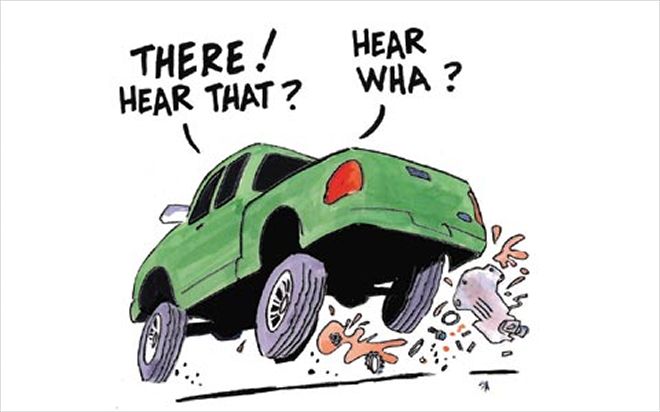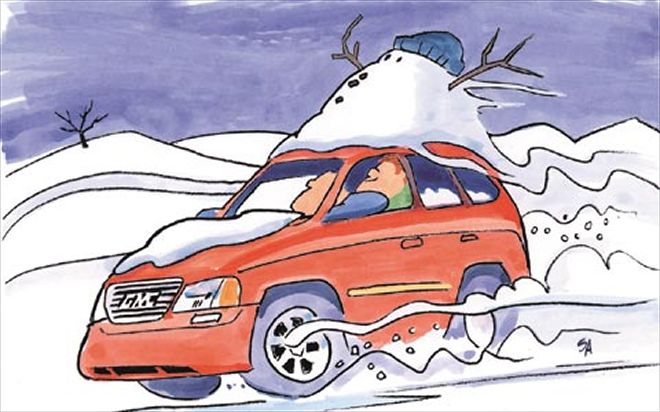Watertight '99 Silverado Pickup Bed Q: My '99 Silverado Pickup has two holes (not the stake pockets) on both front corners of the cargo box between the bed and cab. Run your fingers along the forward top edge, and you can locate them. A lid or cap won't keep the cab watertight. Will Chevrolet correct this?

| 163 0208 Ttg 04 Z
A: Take a closer look at the Silverado's cargo box. The holes you're describing don't go through to the interior at all. They're open to the area between the exterior body panel and the side cargo-box wall. This area is wide open at the bottom. We're confident the holes were either part of the manufacturing process and/or were used for ventilation purposes. Pickup trucks weren't designed to float. You may notice drain holes in the corners. Installing a cap will keep the bed interior dry unless the water level reaches the door handles.
'91 Jeep Cherokee Power Locks Won't Q: My '91 Jeep Cherokee has power door locks that stopped working. The keys work, but not the power buttons on both doors and remote.
A: The power-door lock setup on your Cherokee consists of several components: The master door-lock/power-window switch assembly, and RH door lock/switch assembly, a keyless-entry module, separate lock and unlock relays, and, of course, the door-lock motors located within each door. The system is powered by two sources: the 10-amp dome fuse and the 30-amp power-accessory circuit breaker, both of which are located at the fuse panel. A number of possibilities exist that may completely disable the system, but check the fuse and breaker first. If they're confirmed good, check if there's power supplied to both components, then investigate the circuit voltage and grounds at the lock and unlock relays. The schematic shows a common ground that would kill all power door-lock operation if lost. But you may not be ready to tackle a complex electrical repair. If the fuse and circuit breaker look good, ask a technician to further diagnose the problem.

| 163 0208 Ttg 01 Z
'89 Jeep Cherokee Oil-Pressure Problems? Q: I drive an '89 Jeep Cherokee with the 4.0L engine (123,000 miles). All six connecting-rod bearings have failed, but the main bearings look like new. The engine is original, the oil pump looks perfect, and there's no sludge. Can you suggest why connecting-rod bearings failed and everything else appears in great shape?
A:The 123,000 miles on the clock is a major contributor. Most of the time, connecting-rod bearings will let go before the crankshaft main bearings when a tired engine is on its way out. Once that first fatigued bearing has enough excessive clearance, it'll spin within the connecting rod and its endcap. This allows oil pressure coming from the oil pump to free flow due to lost restriction at the bearing. Then the oil pressure will drop and aid in shortening the life span of the remaining worn-out rod bearing. The main bearings are larger and stronger and may hold up a little longer, but usually you'll have to pull over once that loud knocking noise outplays the radio. The cause can be from a number of sources such as an oil-pressure loss from a faulty oil-pump relief valve or worn camshaft bearings. The oil may have somehow been contaminated, or its time simply has come (and no one will ever know the exact cause of death). It's going to require a complete overhaul without missing a trick, so whatever contributed to the first failure is no longer an issue the next time around.

| 163 0208 Ttg 02 Z
GMC Envoy Limited-Slip Advantages Q: I plan on buying an '02 or '03 GMC Envoy with four-wheel drive. I live in Wisconsin where I experience all the joys associated with winter driving. What are the pros and cons of a limited-slip differential?
A: If you're looking for additional traction in foul-weather conditions, a locking differential is probably the way to go. It boils down to having both rear wheels pushing your SUV as opposed to one or none at all. According to General Motors, it doesn't use a "limited-slip" differential in any of its trucks. It's actually a mechanical full-locking differential that provides significant advantages over a limited-slip in poor-traction situations. The basic purpose behind a differential is to allow rear wheels to move at different speeds when making a turn. This mechanical wonder prevents us from dragging a wheel or breaking an axle during cornering. The drawback to a standard differential is the limited amount of traction it's going to provide. When one wheel loses traction, it'll continue to spin while the other wheel sits and doesn't help at all. This is where General Motor's locking differential has the advantage. When a difference in rear-wheel speeds of about 100 rpm is detected, the mechanical device within the differential locks both axles together and therefore turns both wheels in unison for optimum traction. The system becomes disabled when poor traction is no longer an issue, or, for safety reasons, when vehicle speed hits 20 mph. The locking-differential option, made by Eaton (Option Code G80) on the '02 Envoy goes for about $270 retail, and, depending on your application, is well worth the investment, the same way ABS and traction control are also big advantages in extreme winters.
Synthetic Chevy Silverado Variations Q: I own an '01 Chevy Silverado 1500 with the 5.3L V-8. I changed the oil and filter with conventional oil at 3500 miles. The truck now has 6500 miles. When can I start using synthetic oil? Do you recommend any particular synthetic? At what intervals would you recommend changing synthetic oil for regular-duty driving?

| 163 0208 Ttg 03 Z
A: Synthetic oil is a wonderful thing. Its biggest advantage over conventional motor oil is its ability to maintain viscosity during extreme high and low temperatures. It won't thicken below zero or prevent proper flow to engine parts on cold startup as much as conventional oil, and, when you're hot idling in Death Valley, synthetic oil won't thin out and break down causing insufficient lubrication to the degree conventional motor oil would. Start using synthetic motor oil in your Chevy truck whenever you're ready. A lot of new performance cars come from the factory with synthetic oil. Cheaper brands are out there, but if you're willing to invest the added expense of synthetic oil into your engine, we suggest going all the way with a premium brand (around $25 for a six pack right now). Statements about not having to change your oil as often when using a synthetic lubricant are unfounded. Most labels strongly suggest sticking with the manufacturer's recommended oil-change intervals. Synthetic oil collects dirt and contaminants just like any other oil and needs to be changed in order to keep your engine clean.
Ford F-150 SuperCrew Transmission Woes Q: My '01 Ford F-150 SuperCrew is making a loud knocking noise in the transmission. It occurs when I decelerate to 15 mph and then accelerate. I've taken the truck to the dealer three times and nothing has been done. The last time, the dealer told me this was a characteristic of the truck. I feel like I have to accelerate slowly, or I'll harm the transmission. Do you know what might be the problem?
A: Without using an electronic stethoscope under your truck, I can't be sure of the noise. It may come from a number of areas in the drivetrain or suspension. The dealer might be correct: the knock or clunk you're hearing is normal drivetrain slack and simply a characteristic of the F-series pickup. The best way to confirm or disprove that theory is by taking a ride in a similar truck. If every other one has that same characteristic noise, it may be something you'll have to live with, but if the road test proves your point, and the other trucks are quiet, then the dealer still has some work to do. I made a Technical Service Bulletin search on the SuperCrew and came up with one that could possibly have something to do with the noise you've described. The problem involves incorrect installation of the Planet Support Spring on '99-'01 F-150s with the 4R70W automatic transmission. This spring keeps the planetary gear support secure against the transmission case, and, when not installed in the correct position, will allow the support to shift and make contact with the case during a transmission downshift. To keep it simple, the transmission must be removed and disassembled in order to put this spring back in the right place. Contact your dealer's service department to find out if this has been previously eliminated as a possible cause of your problem.
'02 Avalanche Rearend Noises Q:I own an '02 Avalanche. Since new, the rearend sounds like it has 100,000 miles on it when slowing down from 60 to 40 mph. I took it back to the dealer, and the shop foreman drove it, heard the noise, and had the ring-and-pinion set replaced at 3000 miles; however, it still made the noise after replacing the gears. We then drove three brand-new ones, and all of them made the same noise after the fluid warmed up. I like the service department, but this noise is driving me nutty. What do I do now?
A: You've already done what I would've suggested by taking the same vehicle for a ride and comparing noises. This confirms it's a characteristic of the vehicle's drivetrain and not an actual failure within the rear-axle assembly. It may be the new-style body structure of the Avalanche that allows the transfer of rear-axle noise to the passenger compartment in larger amounts than, say, the Silverado pickup or Suburban SUV bodies. Currently no reports are available that Chevrolet is pursuing repair for the problem. Check with your dealer next year to see if there's been a Technical Service Bulletin published addressing the noise. In the meantime, there's not much you can do. It's being considered a normal characteristic of the latest in pickup and/or SUV design.
 | 163 0208 Ttg 04 Z
A: Take a closer look at the Silverado's cargo box. The holes you're describing don't go through to the interior at all. They're open to the area between the exterior body panel and the side cargo-box wall. This area is wide open at the bottom. We're confident the holes were either part of the manufacturing process and/or were used for ventilation purposes. Pickup trucks weren't designed to float. You may notice drain holes in the corners. Installing a cap will keep the bed interior dry unless the water level reaches the door handles.
'91 Jeep Cherokee Power Locks Won't
| 163 0208 Ttg 04 Z
A: Take a closer look at the Silverado's cargo box. The holes you're describing don't go through to the interior at all. They're open to the area between the exterior body panel and the side cargo-box wall. This area is wide open at the bottom. We're confident the holes were either part of the manufacturing process and/or were used for ventilation purposes. Pickup trucks weren't designed to float. You may notice drain holes in the corners. Installing a cap will keep the bed interior dry unless the water level reaches the door handles.
'91 Jeep Cherokee Power Locks Won't | 163 0208 Ttg 01 Z
'89 Jeep Cherokee Oil-Pressure Problems?
| 163 0208 Ttg 01 Z
'89 Jeep Cherokee Oil-Pressure Problems? | 163 0208 Ttg 02 Z
GMC Envoy Limited-Slip Advantages
| 163 0208 Ttg 02 Z
GMC Envoy Limited-Slip Advantages | 163 0208 Ttg 03 Z
A: Synthetic oil is a wonderful thing. Its biggest advantage over conventional motor oil is its ability to maintain viscosity during extreme high and low temperatures. It won't thicken below zero or prevent proper flow to engine parts on cold startup as much as conventional oil, and, when you're hot idling in Death Valley, synthetic oil won't thin out and break down causing insufficient lubrication to the degree conventional motor oil would. Start using synthetic motor oil in your Chevy truck whenever you're ready. A lot of new performance cars come from the factory with synthetic oil. Cheaper brands are out there, but if you're willing to invest the added expense of synthetic oil into your engine, we suggest going all the way with a premium brand (around $25 for a six pack right now). Statements about not having to change your oil as often when using a synthetic lubricant are unfounded. Most labels strongly suggest sticking with the manufacturer's recommended oil-change intervals. Synthetic oil collects dirt and contaminants just like any other oil and needs to be changed in order to keep your engine clean.
Ford F-150 SuperCrew Transmission Woes
| 163 0208 Ttg 03 Z
A: Synthetic oil is a wonderful thing. Its biggest advantage over conventional motor oil is its ability to maintain viscosity during extreme high and low temperatures. It won't thicken below zero or prevent proper flow to engine parts on cold startup as much as conventional oil, and, when you're hot idling in Death Valley, synthetic oil won't thin out and break down causing insufficient lubrication to the degree conventional motor oil would. Start using synthetic motor oil in your Chevy truck whenever you're ready. A lot of new performance cars come from the factory with synthetic oil. Cheaper brands are out there, but if you're willing to invest the added expense of synthetic oil into your engine, we suggest going all the way with a premium brand (around $25 for a six pack right now). Statements about not having to change your oil as often when using a synthetic lubricant are unfounded. Most labels strongly suggest sticking with the manufacturer's recommended oil-change intervals. Synthetic oil collects dirt and contaminants just like any other oil and needs to be changed in order to keep your engine clean.
Ford F-150 SuperCrew Transmission Woes